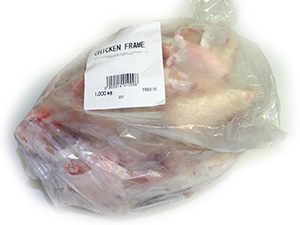Adult Dogs
The recommended amount for raw feeding a healthy, adult dog is 2-3% of their body weight per day.
It is generally recommended to feed adult dogs a smaller meal twice per day, rather than one large feeding. As with humans, it is commonly thought that this supports better functioning of the dog's metabolism and digestive system.
Puppies
Puppies have increased nutritional needs to meet the demands of their growing bodies. Puppies under 12 months of age should be fed approximately 5% of their body weight per day.
Divide the total daily allowance of Raw 4 Paws into 3 meals for puppies under 6 months of age; and into 2 meals for puppies aged from 6 months onwards.
How to calculate
To work out your dog's daily feeding requirement, multiply their weight by 2-3%, or 5% for puppies. For example, to work out what to feed my 5.6kg Cavalier, if working on a ratio of 3% of her body weight:
5.6kg x 0.03 (3%) = 0.168
This means I would feed her 168 grams per day, divided into 2 meals of 84 grams each.
The Healthy Path
Most dogs will love their new, fresh, raw food and the transition will be no more difficult than replacing their old food with the new. Still, there are some dogs (and many cats) who are a little picky and might need some help adjusting to their new healthy eating plan (like the rest of us!).
We've put together some other tips on feeding your dogs and cats to help you achieve the best health for your pets.
FUSSY EATERS
If it takes a little time, that's fine. It's for your pet's best health so be patient and be persistent. Try the following to help the transition:
- Try a different variety, ie. try turkey instead of chicken.
- Mix a little bit of the old food in with the new for the first few days. Gradually reduce the amount of the old food.
- Add a small dollop of plain natural yoghurt in with the BARF.
Do not leave the food down all day as this only increases the fussy nature of some dogs and cats. Allow them 10-20 minutes to eat and if they have left some in the bowl after that time or are just not interested in eating it, take it away. They will likely be hungry at the next meal time and more inclined to eat what is put in front of them.
Do not feed them extra at the next meal time or compensate with little titbits throughout the day. Missing a meal or two on the odd occasion is not harmful.
If the transition is difficult, you may also want to refrain from giving them other food rewards during any training programs. Find another reward or give training a rest for a few days.
A BALANCED DIET
The raw pet food products stocked by Raw Health 4 Dogs have been chosen specifically because they provide a biologically appropriate, balanced diet, straight from the packet.
There is no need to supplement or add other food to your dog's diet if you are feeding Raw 4 Paws or Canine Country BARF.
If you are feeding plain meat and bone then you should consider adding some other ingredients to your dog's diet to provide them with a wider variety of nutrients.
BONES
You may wish to give your dog an occasional raw meaty bone to provide some additional variety and satisfy their natural instincts for chewing and gnawing. Be careful about what type and size of bones you feed to your dog and NEVER feed bones unsupervised. Raw Health 4 Dogs is planning to add some bones and other food products in the future.
TREATS & CHEWS
I give my dogs occasional additional natural treats such as dehydrated plain jerky style chews, dried shark cartilage, kangaroo tendons, dried lamb puffs, etc. One of the benefits of a raw diet for dogs and cats is that the products are natural. Whilst treats such as this are not raw, they are natural, and are only for occasional treats and stimulation. Avoid commercial products that are processed and contain chemicals, preservatives and colours as well as often having high levels of sugar, fat and salt. Natural, natural, natural!
MONITOR AND ADJUST
Be aware of how much you are feeding your dogs and cats. If you are training them and you use positive reinforcement in the form of food rewards, then you must alter their food intake at meal times. Obesity in our pets can cause long term and irreversible damage to their organs, their hormones and their joints.
Similarly, make sure you are feeding your pets enough. If you have started feeding a raw diet based on 2% of their body weight and they appear to be losing too much weight, then increase the amounts you are feeding slightly. Continue to monitor and adjust the amount you feed, as your pet's requirements may change throughout their lifetime depending on their age and the quality and amount of exercise they get.
A healthy body weight on dogs and cats means you should be able to feel their ribs easily but they should not have a sunken appearance or be poking out. They should have a visible waistline just before their back hips, when viewed from above and from the side; you should be able to feel it if your dog or cat is a bit on the fluffy, furry side. If your dog is looking more like a solid, stuffed wombat, you need to reduce the food intake... and possibly increase the exercise.
